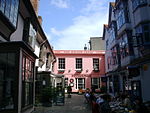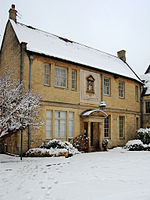Cornmarket Street

Cornmarket Street (colloquially referred to as Cornmarket or historically The Corn) is a major shopping street and pedestrian precinct in Oxford, England that runs north to south between Magdalen Street and Carfax Tower.To the east is the Golden Cross arcade of small jewellery and craft shops in a courtyard, leading to the Covered Market. To the west is the indoor Clarendon Shopping Centre that connects in an L-shape to Queen Street. Cornmarket was semi-pedestrianised and made a limited-access street in 1999. Cycling is allowed 6pm to 10am. In 2002, it was voted Britain's second worst street in a poll of listeners to the Today programme. The rating was largely due to a failed attempt to repave the street in 2001. The granite setts, which had been laid extensively, cracked and the contractor went into liquidation. In 2003, it was repaved again and new benches installed, amidst reports of budgetary problems.
Excerpt from the Wikipedia article Cornmarket Street (License: CC BY-SA 3.0, Authors, Images).Cornmarket Street
Cornmarket Street, Oxford City Centre
Geographical coordinates (GPS) Address Phone number Website Nearby Places Show on map
Geographical coordinates (GPS)
| Latitude | Longitude |
|---|---|
| N 51.753 ° | E -1.2584 ° |
Address
LEON
Cornmarket Street 44-46
OX1 3HA Oxford, City Centre
England, United Kingdom
Open on Google Maps









